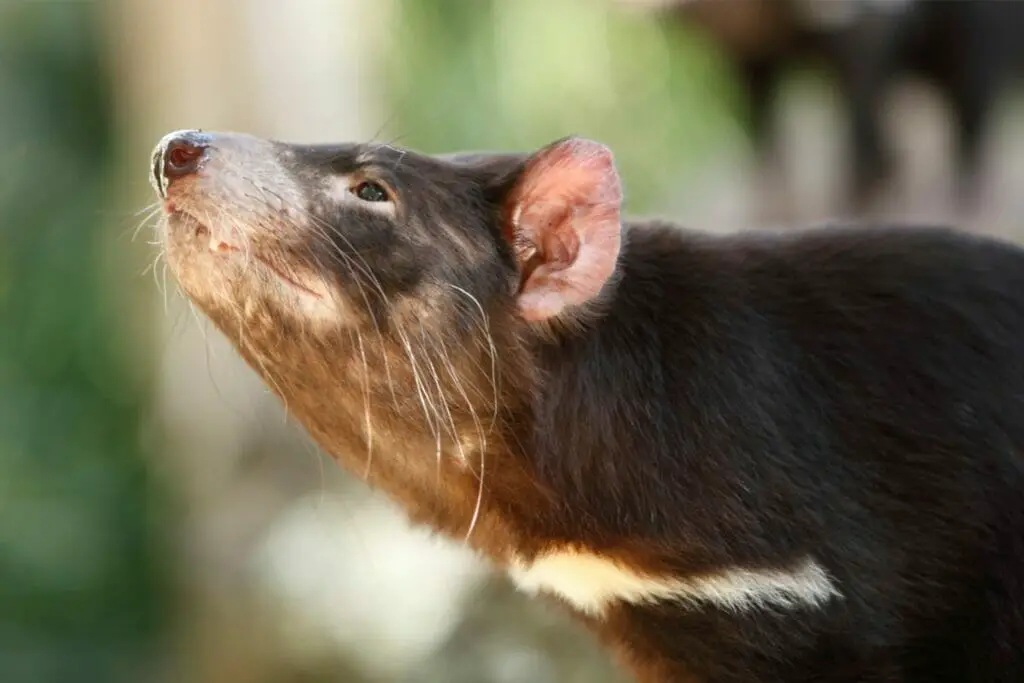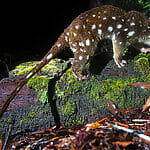Tasmanian devils are fascinating and unique animals that used to be found throughout Australia, but are not only found on the island of Tasmania.
The shrinking of Tasmanian devil territory is due to a number of factors that have significantly decreased the population of these marsupials over recent years.

Unfortunately, because Tasmanian devils have been painted as dangerous and aggressive animals, their near-extinction status is not met with the same urgency by the general public as threats to other, subjectively cuter animals (see also: Animals That Paint).
However, the reality is that if the Tasmanian devil becomes extinct, this could have significant, negative impacts for the local ecosystem and other wildlife populations.
Here’s what would happen if the Tasmanian devil were to go extinct and what we can all do to prevent it.
Why is the Tasmanian Devil Endangered?
The reason why the Tasmanian devil is now nearing extinction is complex and comprises various factors.
Devil Facial Tumor Disease
The most well-understood reason for the Tasmanian devil’s dwindling numbers is something known as Devil Facial Tumor Disease, or DFTD.
Devil Facial Tumor Disease is just as horrible as it sounds. It’s a type of parasitic cancer, which was first officially identified as a diagnosis in 1996.
This type of cancer is transmitted from one Tasmanian devil to another through biting, causing sores around the mouth which develop into cancerous tumors on the face and, eventually, the entire body.
Because it’s so aggressive, nearly 100% of Tasmanian devils afflicted with this disease will die as a result, usually within 6 months.
The exact causes of death are usually either starvation due to the tumors making feeding impossible, organ failure, or infected sores.
Since the initial outbreak of DFTD in 1996, Tasmanian devil numbers have decreased by more than 70%, and sadly, about 80% of Tasmanian devils still alive in the wild have the disease.
Habitat Destruction
Tasmanian devils’ forest habitats are being threatened by deforestation and forest fires.
This has led to something called habitat fragmentation, which not only means that Tasmanian devils have less space to live in, but also that they struggle to breed.
Therefore, as DFTD kills more and more Tasmanian devils, these animals are unable to repopulate fast enough.
With that being said, habitat fragmentation has slowed the spread of DFTD, so there is a slight silver lining to this issue.
Predators
Foxes, dogs and cats are some of the most significant predators for the Tasmanian devil, and since the Tasmanian devil’s natural habitat is being fragmented, they are being forced into closer proximity with these predators.
Foxes, in particular, are known to prey on baby Tasmanian devils, which has an even greater impact on population size because the young are not able to grow up and reproduce.
Road Accidents
Numbers of cars per person are on the increase in Tasmania, and this naturally leads to more road traffic accidents, and more roadkill.
Many Tasmanian devils are killed by cars each year, and while this is true of many species all over the world, roadkill is a bigger problem for Tasmanian devil populations due to the fact that they are already struggling to repopulate due to DFTD, habitat fragmentation, and predators.
What Will Happen If The Tasmanian Devil Goes Extinct?

Current estimates indicate that Tasmanian devils are likely to be extinct by 2035 if immediate steps are not taken to cure DFTD and repopulate this marsupial species.
This could spell disaster for the Tasmanian ecosystem.
While foxes and feral cats can prey on Tasmanian devils (especially babies), Tasmanian devils also see these animals as potential prey, and are responsible for keeping their populations in check.
Without the Tasmanian devil, feral cats and foxes will rapidly grow in number and the mammals that they prey on could soon be the next to face extinction.
If these smaller mammals become extinct, all kinds of wildlife (both flora and fauna) could be affected.
This is because small mammals (the prey of foxes and feral cats) are responsible for enriching soil, which is crucial for forest regeneration.
Forest fires could even increase if these small mammal populations are depleted because leaf litter will remain unburied, speeding up the spread of wildfires.
Additionally, Tasmanian devils are responsible for removing carcasses, which could otherwise spread disease, from their natural habitats.
So, as you can see, the impact of the Tasmanian devil going extinct ranges far beyond the loss of a single animal. The entire Tasmanian ecosystem could be impacted and even destroyed if these animals were to cease to exist.
What Can We Do To Save The Tasmanian Devil?
We know that this article has been pretty doom-and-gloom so far, but there is some good news. Against all the odds, the Tasmanian devil could still have a chance of beating DFTD and continuing to thrive.
Studies have shown that the spreading of DFTD is starting to slow down (possibly, in part, due to habitat fragmentation).
Each Tasmanian devil infecte with DFTD is now only infecting one other Tasmanian devil, which means that eventually the disease could stop spreading entirely.
Tasmanian devils could also have started to develop a resistance to the disease by developing stronger immune systems or changing their behavior to minimize the spread.
However, we can’t afford to wait and see whether DFTD will stop spreading on its own. That’s why conservationists have suggested introducing captive-bred (and, therefore, tumor-free) Tasmanian devils into wild populations to boost numbers.
This is a controversial idea because some scientists argue that increasing population numbers could actually start to speed up transmission, especially if the captive-bred Tasmanian devils haven’t developed resistance through exposure.
Because the best path to saving the Tasmanian devil from extinction is still unclear, one thing we can all do to help save this species is to donate to research efforts into DFTD and the best way to cure and stop the spread of the disease.
Projects are also underway to isolate some Tasmanian devil populations close to Hobart and on Maria Island in order to create thriving Tasmanian devil communities that are not affected by the disease.
You can contribute to Tasmanian devil conservation efforts by donating to the University of Tasmania Foundation, where much of the research into Tasmanian devils and DFTD takes place, or volunteering for the Devil Facial Tumour Disease Team.
The Save the Tasmanian Devil Program is a worthy cause.
By donating to this program, you can support the Tasmanian Devil Roadkill Project, which aims to find hotspots for Tasmanian devil roadkill and make adjustments to these areas to minimize car accidents involving these animals.
Final Thoughts
Tasmanian devil populations are being threatened by Devil Facial Tumor Disease, habitat fragmentation, road accidents, and increasing numbers of predators.
At the current rate, there’s a chance the Tasmanian devil could be extinct by 2035, although the slowing of the spread of DFTD and the momentum of conservation efforts are hopeful signs that this could be avoided.
It’s very important that efforts to save the Tasmanian devil continue.
This is because if these animals become extinct, fox and feral cat populations could explode, leading to fewer small mammals and, consequently, less ecosystem maintenance, which could slow forest growth and worsen the impact of wildfires in Tasmania.
- What Should I Do If A Koala Bites Me? Safety Guide - 2024-05-30
- Are Kangaroos Born Without Hind Legs? A Fascinating Journey - 2024-05-30
- Animals That Look Like Squirrels - 2024-05-30









